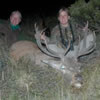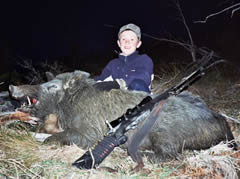The Hossack Station - Where some of New Zealand's finest wild and free big game hunting can be found
Home › Testimonials › Article by Craig Boddington
Article by Craig Boddington
In the far stations: hunting New Zealand will take your breath away in more ways than one.
The brook at the Hossack wound its way down out of the mountains and we followed it up for several hundred yards along the forested edge, then set up to glass the hills from the cover of conifers. A day earlier, from the heights above, we had seen two good stags drinking here, but they had moved into heavy cover long before we could close the distance. They had not been disturbed, and my guide thought there was a good chance for a return engagement.
I don't think we'd been there fifteen minutes when I saw a couple of strange bumps on the skyline, across the stream far, far above us. My Zeiss 10x42s confirmed two red deer, a smaller stag and what seemed a pretty good one, probably the same two from yesterday. I glanced at the rest of the group. The guide and our host, John Angland of Hossack Station, were focused on the nearer slopes where they expected the stags to be, likewise our designated shooter, Donna Grey.
I waited a few seconds. Although it isn't always politically correct to upstage the guides, my hesitation wasn't politeness, but the faint hope that there just might be something a wee bit closer. These two stags were not only a long way off, but a whole lot higher, with many steep, brushy slopes between us.
When I could wait no longer, I tapped the guide on the shoulder and pointed up. "How about those two?"
It was about 4 o'clock, with plenty of good shooting light ahead of us. Just maybe the stags would repeat the previous day's performance and come to the river. We waited, with that precious daylight ticking away. Nothing doing they stayed up on the skyline and were soon joined by a third stag that appeared even larger. The guide, considerably younger than Donna and me, eyed us suspiciously as he gauged the distance and the slope. I was pretty sure that he was pretty sure we'd never make it up there before dark, but since it was his turn to be polite, he never said it. We backtracked, found a crossing that kept our feet more or less dry, and started up.
It was not an easy climb, straight up a steep, brushy slope, then up and down a series of ridges, taking the tough route to stay out of sight. We sneaked a peek on one of several false crests. The stags had moved just a short distance, and two of them were sparring, with the third observing casually. We were down to an hour of daylight and, despite an hour of tough climbing, we were still nearly a half-mile away. I didn't think we'd make it in time, but we had to try.
A half-hour later we had them at 400 yards, with too much open ground between us. Sensibly, the guide asked Donna how far she was comfortable shooting. "Maybe 250," was the confident reply. He nodded and studied the ground ahead.
Minutes passed, and then the stags moved off to the left, allowing us to crawl across a low ridge and duck into nightmarish brush below. Minutes later we reached a little bump in the hillside. The stags were at 300 yards, moving in and out of some brush toward an open saddle. There was one little ridge between us, but the light was going quickly. Without hesitation, the guide led us down off the bump into the dead ground below, and in dimming light we crept up onto that last little ridge.
One of the two larger stags was standing alone in that open saddle, roaring. Two hundred yards. We pushed my pack onto a bush, and Donna slid my Ramirez 7x57 into place. The stag took a couple of steps, stopped, and roared again, silhouetted against the darkening sky. The little rifle went off. The stag turned, tried to run, and pitched forward out of sight. When we found him, he was just a few yards down the steep slope, held up by brush. A fine 14-pointer, an excellent free-range New Zealand red stag.
New Zealand is a gorgeous country, sparsely populated with friendly people, easy to get around in and always fun. It’s always good to have an excuse to go back.
A short history of Red Stags
THE FREE-RANGE New Zealand red stag started with stock from wild deer from Scotland and England--deer that produced modest antlers. Absent parasites and predators, by the 1940s they had bred up to plague proportions, along with numerous other introduced species. The official government policy was--and to some extent still is--eradication. Market hunting became an active industry, and then came helicopters, the era of the Kiwi "chopper boys."
By the 1980s wild red deer were scarce--but the venison and antler market was still good, so deer ranching started to supplant wild venison. The best breeding stock was brought in from Europe, enabling New Zealand deer farmers to produce some of the finest red deer in the world.
Today neither the density of wild deer nor the venison market are able to support helicopter time, so wild red deer are on the increase, especially on rugged South Island. But the wild deer remain modest-antlered descendants of the original modest-antlered releases.
The really great stags, line-bred for many cervidae generations--and which hit the 300-, 400- and the incredible 500-inch mark--are on estates. This is the preferred New Zealand euphemism for "game ranch." Many New Zealand outfitters today offer hunting only on estates. A few, like the Hossack Station, offer a choice between estate and free-range hunting.









